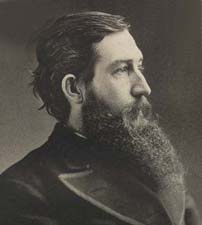 Musician, poet, and writer Sidney Lanier was born in Georgia in 1842 and is considered one of the greatest poets produced by the South in the 19th Century. Born into a family that was steeped in Southern traditions and writing, he went to Oglethorpe College where he distinguished himself during his time there, particularly in the arena of debate.
Musician, poet, and writer Sidney Lanier was born in Georgia in 1842 and is considered one of the greatest poets produced by the South in the 19th Century. Born into a family that was steeped in Southern traditions and writing, he went to Oglethorpe College where he distinguished himself during his time there, particularly in the arena of debate.
He wanted to further his education and studies with a doctorate, but the Civil War intervened, and Sidney Lanier joined the Confederate Macon Volunteers along with his brother. He served in the signal corps in Virginia and, whilst working as a blockade runner, was captured and imprisoned in Maryland. There he caught consumption, a disease for which there was no cure and which he would suffer from for the rest of his life.
After his release, Lanier taught in schools for a while before moving to Alabama, where he worked in a hotel as a clerk and musician. He was a talented flute player and also a regular organist at the local church. While in Alabama, he wrote his first and only novel, Tiger Lilies, which was published in 1867 and is thought to be part autobiography, covering his time from Oglethorpe to the end of the Civil War.
In 1867, he married Mary Day and moved back to Macon, where he worked for his father’s law firm. He wrote poems that explored the South after the war as it went through a process of reconstruction, using Negro and poor white dialects to create verse that resonated with Southern readers and raised questions of the effect change was having on the people and the region.

After taking and passing exams for the bar, he practiced law for a number of years before rediscovering his talent for flute playing whilst in Texas. Sidney Lanier decided to head north to try and find a job as a musician with an orchestra.
He finally became the lead flute player in Maryland’s Peabody Orchestra and wrote more poetry to help support his family. His most famous works were produced at this time, including Corn and The Song of Chattahoochee. He liked to combine nature with religious themes as in his lyrical poem The Marshes of Glynn which also focuses on the industrialization and possible destruction of his beloved South.

Both this and his later work Sunrise explored the musicality that can be brought into verse. Lanier had long been working on his theory concerning how music influences poetry and produced his criticism The Science of English Verse as well as holding a number of lectures on the subject. He also undertook a great deal of research into the works of Shakespeare, Chaucer and other great writers, which again saw him lecturing widely.
After his foray into music with the Peabody Orchestra, he returned for a while to teaching, heading to Baltimore to join the staff at Johns Hopkins University. But the tuberculosis was gradually beginning to take its toll on Sidney Lanier and, in 1881, at the age of just 39, the poet and musician finally succumbed to the disease. He is buried in Green Mount Cemetery in Baltimore.

